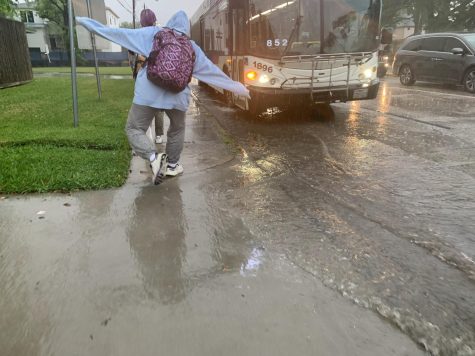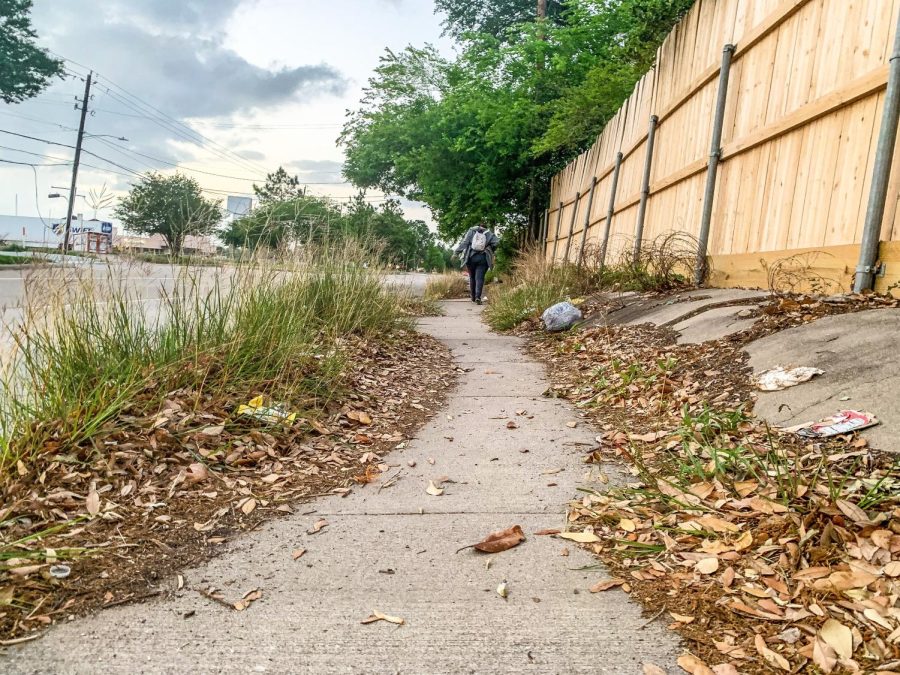Walking in Houston does not have to be this hostile: why we need to demand better streets for pedestrians
A pedestrian walks down the unkempt sidewalks on Braeswood Place. Thin sidewalks covered in foliage are especially difficult for disabled people to navigate.
Walking in Houston is both uncomfortable and dehumanizing. So much so that it makes pedestrians feel like second-class citizens to drivers due to the secondary ranking of pedestrians to cars.
In fact, the best way to describe walking in Houston: hostile. You never know when a sidewalk will abruptly end, or when an obstruction will force you into high-moving traffic. During rainy days, you are constantly in the splash-zone. You never feel safe.
My discomfort and unease with walking became fear for my safety when I read the story of Ryan Lutz, a Houstonian who was killed by a car while on a walk with his dog, Orbit, along the road near 900 West 25th St.
The driver of the Silverado that killed Lutz did admit to driving around 40 mph on a 30 mph road. However, the crash report did not list speeding as a contributing factor to the crash. In fact, the only thing listed in the report was Lutz’s alleged failure to yield right-of-way to the driver.
Located in a residential neighborhood, this section of West 25th has sidewalks on both sides of the street. However, the sidewalks abruptly end around 400 ft from the crash. Cars are also occasionally parked in driveways, blocking portions of the sidewalk from pedestrians and forcing walkers onto the street.
Lutz left behind his wife, Izaura Lutz. If you want to support his family you can donate to their GoFundMe to help cover any medical or possible legal expenses.
What happened to Lutz was a tragedy; one that occurs in Houston far too often. Despite Houston’s Vision Zero plan to end traffic deaths by 2030, there has been an increase in pedestrians killed on roadways in 2022. Furthermore, in the past 10 years, the number of people who have died while walking in the U.S. have increased by over 50%. In Houston, that figure has shot up even higher to an increase of 125%.
The reasons behind this increase include the rising popularity of bigger and deadlier SUVs, which are more likely to kill pedestrians in the event of a collision. Additionally, rising speed limits are also correlated with increased deaths, especially in Texas where you can legally drive up to 85 mph on certain roads.
American roads are simply dangerous by design, and to combat the rising numbers of people struck while walking, we need fundamental changes in road infrastructure.
If you drive to every destination, I challenge you to try walking or taking the bus to work for one day. Too often, those who drive cars do not understand the reality of those who do not have the luxury of owning a private vehicle. It’s easy to describe the humiliation of getting splashed by rainwater, but until those in the vehicles experience it for themselves, there will never be change.
We must shift our focus on automobiles to a more multimodal approach. This means we need to build more bike lanes and pedestrian friendly streets to accommodate all modes of transportation. Currently, car-centric roads lead to widening streets, which takes up space that could be used for biking or walking. Wider streets also encourage drivers to go faster, which creates dangerous environments for pedestrians.
Right now, roads are designed to move cars from point A to point B as quickly as possible.The prioritization of the quick movement of vehicles harms pedestrian safety because, to put it simply, you cannot prioritize both safety and speed. One must be sacrificed for the other.
According to Maragret Flippen, a city and regional planner who focuses on creating walkable cities, car-centric roads are a major issue in Houston. Car-centric roads are streets that have wide roadways, narrow sidewalks, and little crosswalks. Furthermore, the wider streets also encourage cars to go faster.
“They just keep widening the streets,” Flippen said in our interview. “And in doing so they’re taking away that public right of way that could be used for other modes of transportation like walking and biking.”
Walking home on Stella Link Road, the sidewalks are often cracked or unkempt. Shrubs and weeds block your path, pushing you off the sidewalk and into the street, all while cars whiz past you at up to 50mph. Even worse, when it rains, the speeding cars splash dirty street water onto you.

For Margaret Flippen, a Houston city and regional planner who focuses on creating walkable cities, this shift to a more multimodal approach requires more than just installing sidewalks.
“It’s not just installing a sidewalk, but installing all the elements that make a pedestrian feel safe,” Flippen said. “So one thing is wider sidewalks and street trees because they not only protect you from cars whizzing by, but they also offer shade.”
ADA-accessible streets are also a vital aspect in creating more walkable cities.
“It’s so important with intersections that they have the ramps going down as well as the crosswalk signals,” Flippen said. “[We need] to make sure that there’s enough time for someone in a wheelchair or someone with a seeing eye dog to safely cross the roadway.”
Flippen also said she wants to lower speed limits in neighborhoods and enforce speed limits.
“I’m a big fan of adding stop signs in Houston neighborhoods,” Flippen said. “I think the maximum speed is 30 or 35, whereas it should be like 25 or 20.”
According to Flippin, the wide streets in Houston encourage drivers to go faster.
“If you’re on any of our streets, you can go 50 mph and not think twice about it,” Flippen said. “That’s terrible, you should not feel that comfortable. Especially where people are walking and living and biking.”
We need major changes on our roads. If drivers continue to live in their mechanical bubble, we will never gain enough momentum to change streets. Everyone needs to step out of the car and experience commuting by foot.
If you want to create change, call or email the Houston Planning Department at 832.393.6600 or [email protected] . Send them pictures or stories of your own experience commuting outside of a car in Houston.
Dangerous car-centric infrastructure creates a terrible transportation experience for anybody who is not in a car. Less bike lanes. Narrower sidewalks. Faster cars. More deaths.
Walk these roads. Feel the uneasiness. Realize that they need to change.
Your donation will support the student journalists of Bellaire High School. Your contribution will allow us to purchase equipment and cover our annual website hosting costs.








Jonathan Huy Lê • Nov 13, 2024 at 4:09 pm
I used this for my ELA assignment about Houston’s lack of walkability. Tysm!!! ^^
Liyan Feng • Jun 8, 2022 at 6:25 pm
I agree that Houston’s roads should be more pedestrian friendly. There are other negative side effects of being so car-centered, including air and noise pollution. Cars are also more expensive than shoes, bikes, and bus/tram tickets, which limits the mobility and job opportunities of lower-income people. I have found the YouTube channel Not Just Bikes who is focused on urban planning than supports bike, pedestrian, and public transport. Here is the link to his channel:
https://www.youtube.com/c/NotJustBikes